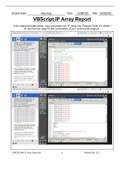Resume
Strategic management summary
- Cours
- Strategic Management
- Établissement
- Vrije Universiteit Brussel (VUB)
Summary of strategic management based on the slides, book and the course thought by Prof. Dr. Elvir Haezendonck. Summary of the theory and cases.
[Montrer plus]













